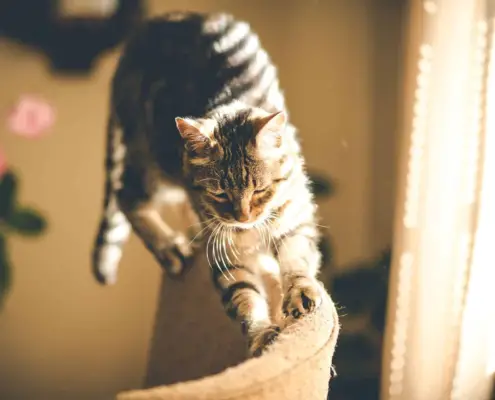
Losing a beloved pet can be a distressing experience for any cat owner. When a cat goes missing, it is crucial to act quickly and methodically to increase the chances of finding them and bringing them back home safely. This ultimate guide will provide you with comprehensive tips and strategies to help you in your search for a missing cat.
The Importance of Acting Quickly When a Cat Goes Missing
Time is of the essence when it comes to finding a missing cat. Cats are naturally curious creatures, but they can also be easily frightened and disoriented when they find themselves in unfamiliar surroundings. Acting promptly can prevent your cat from venturing too far from home and getting lost in an unfamiliar territory.
The first step is to thoroughly search your own property, including all the nooks and crannies where a cat might hide. Cats are notorious for finding the most unexpected hiding spots. Check under porches, in sheds, and behind furniture. Use a flashlight to search dark areas and call out your cat’s name softly.
Next, notify your immediate neighbors about your missing cat. Provide them with a physical description and any other relevant details. They can keep an eye out for your cat and alert you if they spot any sign of them. The sooner you inform your neighbors, the more eyes you will have on the lookout for your furry friend.
Tips for Searching for a Missing Cat in Your Neighborhood
When searching for a missing cat in your neighborhood, it is important to remain calm and focused. Start by canvassing the area immediately surrounding your home and gradually expand your search radius. Cats are known to hide close to their territory, especially if they feel scared or threatened.
Carry a bag of your cat’s favorite treats or a can of their favorite food with you as you search. The sound or smell of a familiar treat can entice a cat to come out of hiding. Shake the treat bag or open the can, calling your cat’s name softly. Be patient and listen for any signs of movement or meowing.
As you search, pay attention to any clues that might indicate your cat’s presence. Look for paw prints, tufts of fur, or scratched tree trunks. Cats are creatures of habit and tend to follow established paths, so focus your search on areas where they might feel comfortable.
Utilizing Social Media and Online Resources to Spread the Word
In today’s digital age, social media and online resources can be powerful tools for finding a missing cat. Start by posting a detailed description and a clear photo of your cat on your own social media accounts. Ask your friends and followers to share the post to increase its reach.
Additionally, there are numerous online platforms dedicated to helping reunite lost pets with their owners. Websites like “Lost and Found Pets” and “Petfinder” allow you to create a profile for your missing cat, complete with photos and contact information. These platforms have large networks of pet lovers who can help spread the word and keep an eye out for your cat.
Remember to also join local community groups and forums on social media. These groups often have members who are passionate about helping lost pets find their way back home. Post in these groups and ask for their assistance in sharing your cat’s information.
Contacting Local Shelters and Organizations
Local animal shelters and organizations can be valuable resources in your search for a missing cat. Contact them as soon as possible and provide them with a detailed description of your cat. Many shelters have a dedicated lost and found section on their websites where you can submit information about your missing pet.
Additionally, some shelters offer services like setting up humane traps or loaning out equipment like motion-activated cameras to help track and capture lost cats. Take advantage of these resources and work closely with the shelter staff to increase your chances of finding your missing cat.
Setting up Feeding Stations and Traps
Setting up feeding stations and traps can be an effective way to attract a missing cat back home. Place a bowl of your cat’s favorite food and a familiar-smelling blanket or piece of clothing near your home or in areas where your cat has been spotted. Leave it out overnight and check the next morning for any signs of your cat’s presence.
If you suspect that your cat is staying within a specific area but is too scared to come out, consider setting up a humane trap. These traps are designed to safely capture cats without causing them harm. Consult with local animal control or a shelter for guidance on how to set up and use these traps correctly.
The Power of Community Involvement in Finding a Missing Cat
When it comes to finding a missing cat, the power of community involvement cannot be overstated. Reach out to your neighbors, friends, and local community organizations for support. Distribute flyers with your cat’s photo and contact information in your neighborhood and nearby areas. Many people are willing to help reunite a lost pet with their owner, so tap into the collective effort of your community.
Consider organizing a search party or a neighborhood watch to comb through the area together. Assign different search areas to volunteers and make sure to provide them with clear instructions on what to do if they find your cat. The more people actively looking for your cat, the higher the chances of a successful reunion.
What to Do If You Find a Cat That Might Be Yours
If you come across a cat that matches the description of your missing pet, approach them cautiously and try to gain their trust. Offer them some food and water, speaking softly and reassuringly. If the cat seems receptive, gently check for any identifying features like distinctive markings or a microchip.
If the cat allows you to handle them, take them to a nearby veterinarian or animal shelter to have their microchip scanned. A microchip is a small device implanted under a cat’s skin that contains their owner’s contact information. It can be a crucial tool in reuniting a lost cat with their owner.
Resources and Tools for Finding Missing Cats
In addition to the strategies mentioned above, there are several resources and tools that can aid in your search for a missing cat. Here are a few worth exploring:
- GPS trackers: Attach a GPS tracker to your cat’s collar to monitor their movements and location in real-time.
- Lost cat databases: Some websites and apps allow you to register your missing cat and receive alerts if a similar cat is found.
- Lost cat posters: Create eye-catching posters with your cat’s photo and your contact information. Hang them in public places like community boards, vet clinics, and pet supply stores.
- Local media: Contact local newspapers, radio stations, and television channels. They may be willing to share your cat’s story and help spread the word.
Remember, the more avenues you explore, the better your chances of finding your missing cat.
Preventative Measures to Keep Your Cat From Going Missing
While it’s essential to know how to find a missing cat, it’s equally important to take preventative measures to keep your cat from going missing in the first place. Here are some tips to help ensure your cat’s safety:
- Microchip your cat: As mentioned earlier, microchipping your cat can greatly increase the chances of being reunited if they go missing.
- Secure your home: Ensure that your home is escape-proof by checking for any gaps or openings that a curious cat could slip through.
- Supervise outdoor time: If you allow your cat outdoors, supervise their activities and provide a safe and enclosed space for them to explore.
- Collar with identification: Have your cat wear a collar with a visible identification tag containing your contact information.
The Joy of Being Reunited With Your Missing Cat
The bond between a cat and their owner is a special one, and the joy of being reunited with a missing cat is indescribable. By acting quickly, utilizing various resources, and involving your community, you can increase the chances of finding your missing cat and bringing them back home safely. Remember to remain persistent, stay positive, and never lose hope.
If you enjoyed my article, I would appreciate you sharing it with your network.

Sima Ndlebe
Sima writes for CatBuzz. He is interested in Cats, Health and Fitness, and Entrepreneurship.
Published: 15 November 2023



